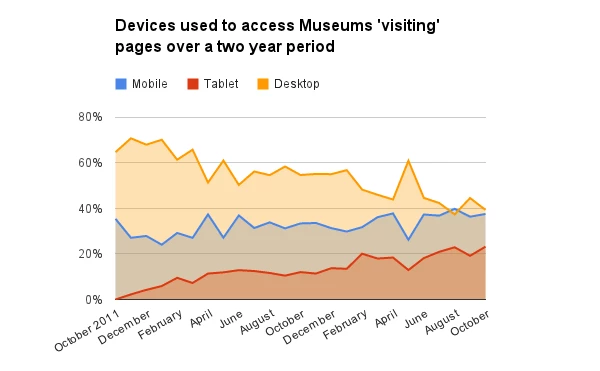The steady march of the mobile device
, 14 November 2013
Graham Davies, Online Curator, Amgeddfa Cymru - National Museum Wales
Access to online content is showing a steady shift towards the mobile device. What are the implications for Amgueddfa Cumry’s own website?
There has been much discussion in the museums digital sector lately on the significant rise in websites accessed via mobile devices. It was one of the focuses of the 'Let's Get Real' Action Research project run by Culture24, of which the Museum was a part. The V&A have recently been publishing their findings on what devices people use to access different areas of their website.
In light of this, I decided to uncover the trends taking place on the National Museum Wales own website: museumwales.ac.uk
Mobile device growth over two years
From the National Museum Wales’ perspective the rate of acces from mobile devices shows pretty much the same pattern reported from other similar institutions.
Overall, we see close to a 25% rise in visits via mobile device to the website over a two year period. This is significant, but applying this as a generalisation of the website as a whole may be hiding other, more significant trends.
Figure 1 shows that people are increasingly looking at our website through mobile devices, but what parts of the site are fuelling this rise? What other trends become apparent when we look at areas such as visiting information, or our content rich collections pages?
So, lets break this down and let's see if we can work out what’s going on here…
What are people mainly looking at when using mobile devices?
A comparison of Figure 2 and Figure 3 clearly show a markedly higher percentage of pages accessed via mobile device to our 'visiting' pages than our content rich Art Online collections pages, (which incidentally show more of a rise in tablet use than mobile.)
What this all boils down to is that our content is now being accessed (and increasingly so) through all manner of different devices, and in all manner of different environments, from coffee shops, trains, your sofa, at work etc., etc.
The devices we choose are driven by the context (or setting) we are in, also the time we have to find out what we need to know. Think about it for a minute. How do you use digital devices to locate and find out information? Sat at a desk in your lunchtime, with time to sift through search results to find local events this coming weekend, filtering and refining on a large screen with a mouse and keyboard. Then there’s that last minute check on opening times and directions on your mobile phone whilst in a crowded train on your Friday night commute, straining to keep your phone viewable whilst jammed up against another person, typing with one finger. Come Sunday evening, you’re lying on the sofa, tablet on lap learning more about that nugget of information you picked up, or writing about your experiance on a review site.
This behaviour is quite logical if we take time to consider user behaviour on different devices, but what does this mean for our website and how we manage it?
What we must ensure when publishing our content is that we understand that the users could be anywhere, doing anything. A the moment, the evidence seems to suggest most mobile access targets visiting and location based information, whereas in depth collections data remains to be largely accessed via desktops.
The decline of the desktop (well, for visiting information at least)
Figure 2 shows that more people are viewing our visiting information from mobile devices than they are from desktops or laptops. It is therefore critical when planning content and designing websites, that areas of the website need to be thought out in separate ways, with visiting and site based information being designed and created first and foremost to be viewed on mobile devices.
In addition to functionality and design, we must also ensure that the content we provide for those areas of the website that are accessed primarily through mobile devices is crystal clear, succinct and quick to discover and understand - after all, you may only have a 5inch screen to get your information across.
Given the rate of growth from mobile devices it will be interesting to see where we will be this time next year...
Background reading:
V&A Blog
Google research
Adobe Digital Marketing blog




